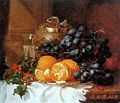Eloise Harriet Stannard
Eloise Harriet Stannard (* 1829 in Norwich , England; † February 2, 1915 there ) was an English painter of still lifes . She is counted to the Norwich School .
Life
Eloise Harriet Stannard was born in 1829 in Norwich , Norfolk , England , as one of 14 children of Alfred Stannard (1806–1899), brother of Joseph Stannard (1797–1830), both major landscape painters of the Norwich School . She learned from her father, probably together with her cousin Emily Stannard (1803-1885), daughter of Joseph Stannard, and Maria Margitson, a niece of John Berney Ladbrook, drawing from her father. With limited health, she rarely stayed outdoors and achieved her mastery in still life painting at a young age . First exhibition contributions in the British Institution (London) go back to 1852, followed in 1856 by her first exhibition in the Royal Academy of Arts (London). Around 30 more exhibitions were to follow in each of these two leading houses throughout their lives. Eloise Harriet Stannard already sold her works extremely successfully during her lifetime (allegedly all of the oil paintings she sent to London for exhibitions were also sold there), initially in Norwich, and later regularly in London. After the death of her mother in 1873, she took on numerous responsibilities in the large family and could no longer build on her previous productivity and quality. From the later years it is mainly smaller formats (8 to 15 in. Side length) and more of a study, on which she worked continuously in the studio until old age. Eloise Harriet Stannard died on February 2, 1915, unmarried and childless in Norwich .
Subjects
Only still lifes in oil on canvas by Eloise Harriet Stannard are known, especially fruits (these more often than flowers), which are presented in baskets and bowls on a cautiously placed stone slab in bright colors and skillfully accented with leaves and foliage against a mostly monochrome background become. Invoices from local fruit dealers for the fruits such as pineapples, pomegranates, etc., which were quite exotic in eastern England at the time, have been preserved to this day and testify to the artist's will to render detailed images as realistic as possible. Small animals (insects, beetles, snails) occasionally complement the mainly summer and autumn arrangements in a reserved manner. We rarely see winter scenes, birds or venison (this is a central theme for Emily Stannard in particular) as the main motif. Berries and small baskets are typical of her late work.
The partly large-format works (up to 30 in. Side length) from the early years 1850 to 1870 clearly stand out qualitatively from the oeuvre. She reached the zenith of her skills in the combined still lifes of flowers and fruits in the 1960s. The inspiration of the stylistic works by de Heem (especially garlands and bouquets at Cornelis de Heem ) and by van Huysum (especially the work of the late Jan van Huysum ) is clearly recognizable. Around 1865 Stannard parted with the coloring of the early Dutch and the bright colors typical of their works moved into their paintings. The motifs are now placed in an outdoor context, the depiction in direct sunlight creates a luminosity that will remain characteristic of her paintings. Stannard enhances the color impression by applying several layers of different colors on top of each other so that the layers underneath partially shine through and give a special color impression. The compositions increasingly place contrasting colors in the immediate vicinity. From 1865, brown, earth-colored shadows and backgrounds replaced the previously cool blue / gray / green surfaces. Texture effects of the fruits are never achieved by applying paint in relief. The brushstroke is very fine and barely recognizable, the application of paint often appears unusually smooth when viewed from the light. A large number of the works are set as a round or oval medallion. These are often still in the ornate original frames provided by P. Townsend, a local art dealer with whom her father worked.
signature
Typically, the legible signature of the oil paintings in handwritten curved letters can be found on the lower right or left as EH Stannard or EHS , usually supplemented by a four-digit year. The H. often seems like a M . It is not uncommon for the signature to be placed diagonally.
Reception today
The pleasing still lifes are a popular motif for commercial reproductions on posters, calendars, postcards, etc., and are therefore widely known to a wide audience because of their outstanding quality, color and their penchant for detailed realistic depiction, especially of the surfaces of fruits and leaves. The privately owned works, which are auctioned a few times a year, especially in London and eastern England, attract attention on the international market and often reach collector's prices. As in her lifetime, Eloise Harriet Stannard is one of the most outstanding still life painters in Europe in the 19th century.
Works in collections
The largest public collection of EH Stannard's work is in the Norwich Castle Museum. Numerous smaller and later works are in private hands, mainly in Norwich; individual outstanding paintings in international private collections. Major major works include By the Old Garden Wall from 1864 (25 × 31 in.) And Garland of Fruits and Flowers from 1865 (30 × 24 in.).
literature
- The Norwich School of Painters , Harold AE Day, Vols II and III, East Anglian Painters, Eastbourne Fine Arts, 1979
Web links
- Norwich Castle Museum & Art Gallery (English)
| personal data | |
|---|---|
| SURNAME | Stannard, Eloise Harriet |
| BRIEF DESCRIPTION | English painter of still life |
| DATE OF BIRTH | 1829 |
| PLACE OF BIRTH | Norwich , England |
| DATE OF DEATH | February 2, 1915 |
| Place of death | Norwich , England |




